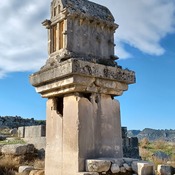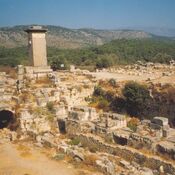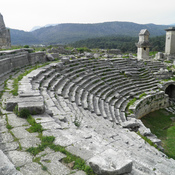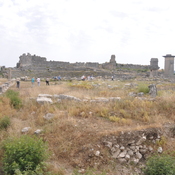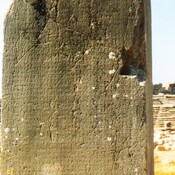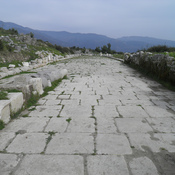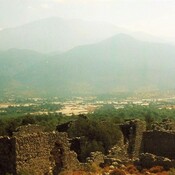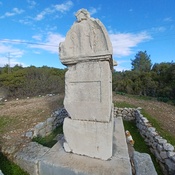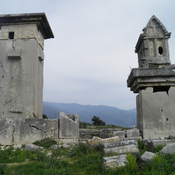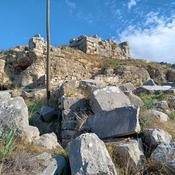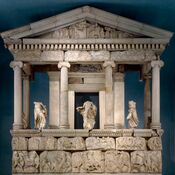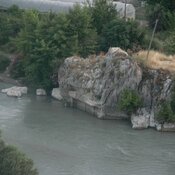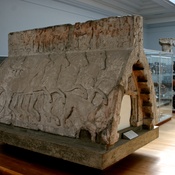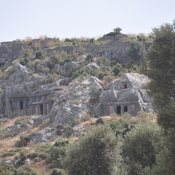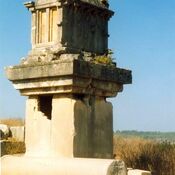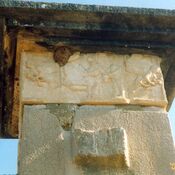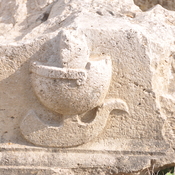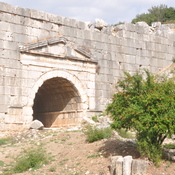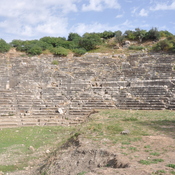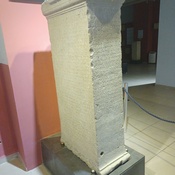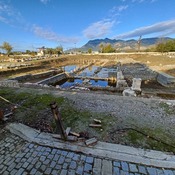Es gibt noch keine deutschsprachige Anmerkungen. Präsentiert wirden Anmerkungen auf English.
The Monument of the Harpies erected in a very special place on the way to acropolis and just at the theatre . It dates back 480 - 470 BC. The main part - a grave chamber made of imported marble decorated with relief on each side was placed on a tall pillar. It takes the name from the dubious interpretation of the relief with four carved female winged figures, resembling Harpies. The arguments leveled by G.E. Bean are far more convenient and explaining the situation depicted. The most logical explanation of the portrayal from the cemetery is that one from eschatological point of view. It allowed him to regard the scene as displaying the Sirens carrying the souls of the dead, in the form of children to the Isles of the Blessed1. 2The original reliefs were taken by Charles Fellows and are now in the British Museum but have been replaced by some casts.
See:
Catherine Draycott, “Dynastic Definitions. Differentiating status claims in the archaic pillar tomb reliefs of Lycia.” Anatolian Iron Ages 6, ed. by A. Sagona and A. Çilingirloglu, 103-134 (inlcuding discussion of Harpy Monument at Xanthos) , pp. 119nn- https://www.academia.edu/342619/2007
Referenzen
- ↑↑George E. Bean, Lycian Turkey: An Archaeological Guide, London John Murray Publishers Ltd 1989, p. 56-58
- ↑Catherine Draycott, Bird-women on the Harpy Monument fromXanthos, Lycia: sirens or harpies?, in Essays in classical archaeology for Eleni Vassiliou 1977-2007. Oxford: Archaeopress, pp. 145-153. BAR international series. (1796) - https://www.academia.edu/342608
The Monument of the Harpies erected in a very special place on the way to acropolis and just at the theatre . It dates back 480 - 470 BC. The main part - a grave chamber made of imported marble decorated with relief on each side was placed on a tall pillar. It takes the name from the dubious interpretation of the relief with four carved female winged figures, resembling Harpies. The arguments leveled by G.E. Bean are far more convenient and explaining the situation depicted. The most logical explanation of the portrayal from the cemetery is that one from eschatological point of view. It allowed him to regard the scene as displaying the Sirens carrying the souls of the dead, in the form of children to the Isles of the Blessed1. 2The original reliefs were taken by Charles Fellows and are now in the British Museum but have been replaced by some casts.
See:
Catherine Draycott, “Dynastic Definitions. Differentiating status claims in the archaic pillar tomb reliefs of Lycia.” Anatolian Iron Ages 6, ed. by A. Sagona and A. Çilingirloglu, 103-134 (inlcuding discussion of Harpy Monument at Xanthos) , pp. 119nn- https://www.academia.edu/342619/2007
Referenzen
- ↑↑George E. Bean, Lycian Turkey: An Archaeological Guide, London John Murray Publishers Ltd 1989, p. 56-58
- ↑Catherine Draycott, Bird-women on the Harpy Monument fromXanthos, Lycia: sirens or harpies?, in Essays in classical archaeology for Eleni Vassiliou 1977-2007. Oxford: Archaeopress, pp. 145-153. BAR international series. (1796) - https://www.academia.edu/342608



